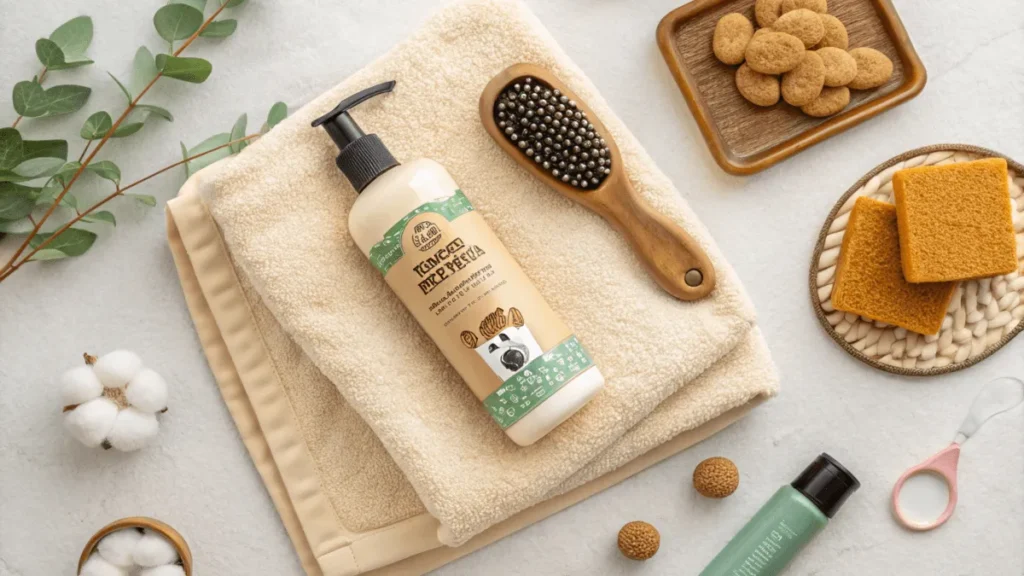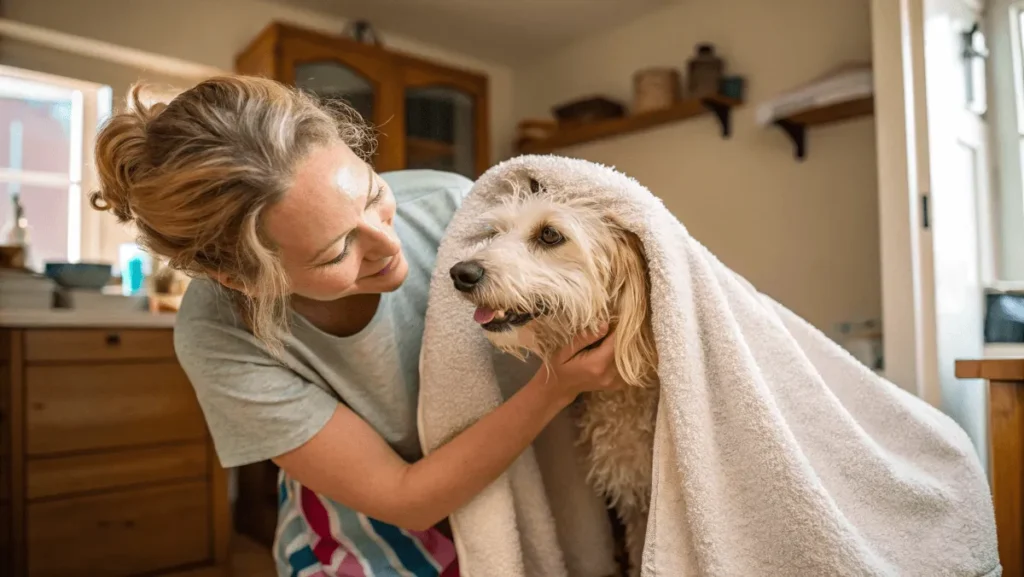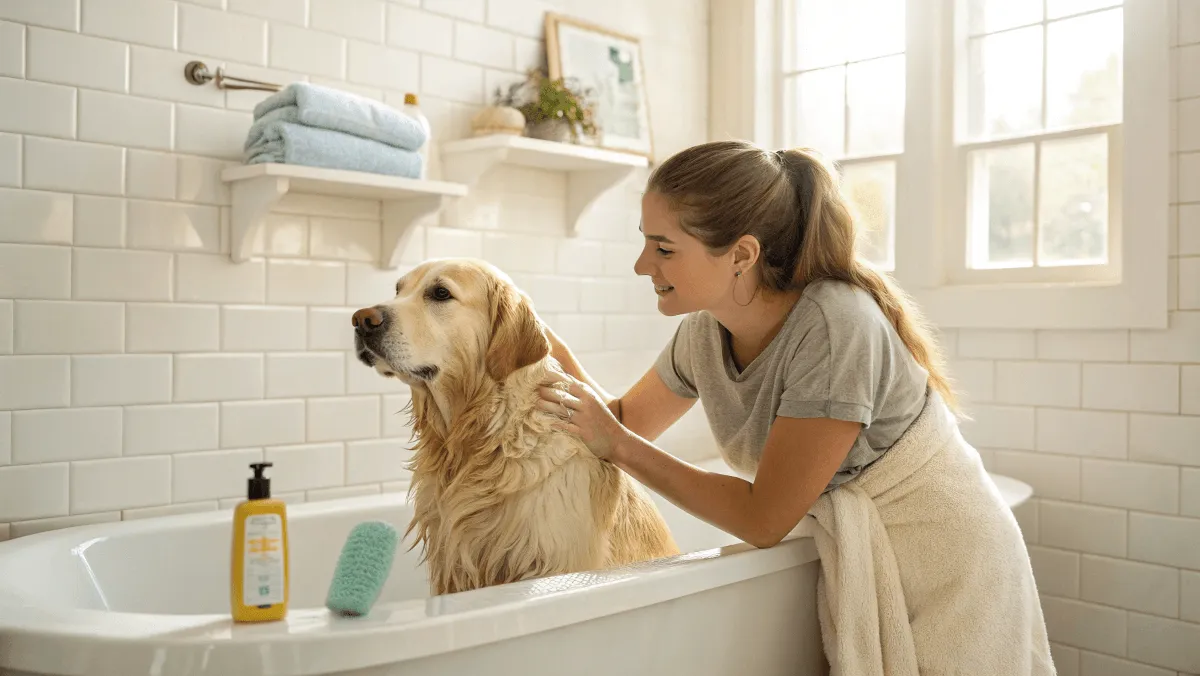Ever tried to wash your dog at home and ended up with a soaked bathroom and a sprinting pup? You’re not alone. Bathing your dog at home can feel like a chaotic adventure—but with the right know-how, it becomes a fun and rewarding bonding moment for both of you.
In this ultimate guide, we’ll walk through everything you need to master how to wash your dog at home—from frequency, prep, and drying to tools and techniques that even soothe anxious pups. Whether you have a playful Labrador or a nervous little terrier, this guide is packed with tips and tricks that make bath time easier, safer, and even enjoyable.
Let’s dive into the suds and smiles!
Why Bathing Your Dog at Home Matters
The Benefits of DIY Dog Baths
Giving your dog a bath at home isn’t just about keeping them clean—it’s an opportunity to connect, observe their health, and build trust. Unlike quick trips to a groomer, an at-home bath allows you to go at your pet’s pace. You’ll notice things you might otherwise miss: skin irritation, fleas, ticks, or even changes in coat texture. These little observations can make a big difference in early detection of health issues. For more wellness tips, check out our complete dog care guide.
And let’s not forget—dogs love routine. Once you develop a calm, consistent bath process, most dogs come to expect (and even enjoy) their grooming time.
Cost Savings vs. Groomer Visits
Let’s face it—professional grooming isn’t cheap. A single visit can cost anywhere between $30 to $90, depending on breed and services. Multiply that by 12 months, and you’ve got a hefty annual bill.
Washing your dog at home can cut those expenses dramatically. After an initial investment in supplies like shampoo, brushes, and a quality towel, your recurring costs are minimal.
Plus, there’s peace of mind. You know exactly what products you’re using and how gently your furry friend is being handled.
The Bonding Experience
Bath time is a great moment to strengthen your bond with your dog. The one-on-one attention, gentle touch, and words of encouragement all help build trust and love. If your dog senses you’re calm, they’ll begin to relax too.
In short, bathing your dog at home is more than a chore—it’s a care ritual filled with benefits for both body and heart.
How Often Should You Bathe Your Dog?
Breed and Coat Type Factors
Not all dogs are created equal when it comes to how often they need a bath. Some breeds—like Labrador Retrievers or Golden Retrievers—have water-resistant coats and natural oils that protect their skin, so bathing too often can actually strip away that protection. On the other hand, breeds like Poodles or Yorkies have hair rather than fur and may need more regular cleaning to prevent matting and odor.
Here’s a quick cheat sheet:
- Short-haired dogs: Every 2–3 months
- Long-haired or thick-coated breeds: Once a month or as needed
- Hairless breeds (e.g., Xoloitzcuintli): Every 1–2 weeks (they get oily faster)
Knowing when and how to wash your dog properly helps maintain their skin and coat health.
Lifestyle, Allergies, and Skin Health
Aside from breed, your dog’s daily life plays a big role. Is your pup a couch potato or a mud puddle enthusiast? Dogs who spend a lot of time outdoors, roll around in grass, or go swimming may need more frequent baths. Also, if your dog has allergies, sensitive skin, or a history of infections, your vet may recommend a specific bathing schedule or medicated shampoo.
The golden rule? When your dog stinks, it’s bath time. But when in doubt, less is more. Too-frequent bathing can dry out their skin and lead to itchiness or irritation.
What You’ll Need Before Bathing

Essential Supplies (Shampoo, Towels, Brush)
Before you wash your dog, make sure you have these essentials ready, gather everything you need. Bath time is easier and safer when you’re fully prepared. Having these items ready makes it much easier to wash your dog without stress or delays.
Here’s your checklist:
- Dog-specific shampoo (never human shampoo—it can irritate their skin)
- Large, absorbent towel or microfiber pet towel
- Detangling brush or slicker brush (especially for long-haired breeds)
- Non-slip bath mat (so your dog doesn’t slip)
- Plastic cup or detachable shower head for rinsing
- Treats (to reward calm behavior)
- Cotton balls (to gently place in their ears and keep water out)
Having these items prepared makes it easier to wash your dog without delays.
Choosing the Right Dog Shampoo
Not all shampoos are created equal—and your dog’s skin pH is different from yours. Look for soap-free, hypoallergenic formulas that are made for dogs.When you wash your dog, oatmeal-based shampoos are gentle and moisturizing—perfect for pups with dry or sensitive skin. For dogs with flea issues, look into vet-approved flea shampoos.
Avoid products with artificial dyes, parabens, or strong fragrances. They might smell nice to you, but can irritate your dog’s skin.
If your vet has recommended a medicated shampoo, make sure to follow the instructions closely—some need to stay on for a few minutes before rinsing. And for ongoing support between baths, our dog supplement guide for coat and skin health highlights natural ways to reduce dryness, shedding, and itchiness from the inside out.
Step-by-Step Instructions to Wash Your Dog at Home
Preparing the Bath Area
First things first—location matters. If you have a small dog, the kitchen sink or a deep laundry tub might be perfect. Larger dogs often need a bathtub, walk-in shower, or even an outdoor bath with a hose on warmer days. For more expert tips, PetMD’s expert guide on how to bathe a dog breaks down everything from safety steps to shampoo selection.
Lay a non-slip mat down to avoid injuries. Have all your supplies within arm’s reach so you’re not scrambling mid-bath.
Next, brush your dog thoroughly before getting them wet. This helps remove loose fur, dirt, and tangles (especially important for long-haired breeds). Matted fur + water = a grooming nightmare.
Put cotton balls gently in your dog’s ears to prevent water from entering and causing infections.
How to Wash Your Dog Safely and Rinse the Right Way
- Start with lukewarm water—never hot. Wet your dog from the neck down using a detachable showerhead or a cup.
- Before you wash your dog, make sure they’re calm and reassured with gentle words or treats. Apply shampoo and lather gently, avoiding the eyes and ears. Start at the neck and work toward the tail, massaging the suds in with your fingertips.
- Don’t rush the rinse! Leftover shampoo can cause itching. Rinse until the water runs completely clear.
- If using a conditioner, repeat the same method and rinse thoroughly.
- Use a soft washcloth for the face, wiping gently around the eyes and mouth.
Once you’re done, wrap your pup in a towel like a burrito to absorb excess water. For dogs who tolerate it, a pet-safe blow dryer on low heat can speed up the process. Always dry the ears carefully with a soft towel—never insert anything deep inside. The more often you wash your dog using these steps, the easier bath time will become.
How to Keep Your Dog Calm
A relaxed dog is much easier to bathe. Try these tricks:
- Use a lick mat smeared with peanut butter on the wall of the tub.
- Speak softly and use their name often.
- Keep bath sessions short and positive—end with their favorite treat or toy.
If your dog is truly fearful, don’t force it. Try shorter sessions, or introduce water gradually with play.
Common Mistakes to Avoid
Using Human Shampoo
It might be tempting to use your favorite lavender shampoo on your pup, but don’t do it. Human products disrupt a dog’s skin pH and can cause dryness, irritation, and allergic reactions. Always use vet-approved, dog-specific formulas.
Even baby shampoo, though mild, isn’t ideal for regular use. When in doubt, go for a natural, soap-free dog shampoo designed for sensitive skin.
Water Temperature and Ear Care Errors
Using water that’s too hot or too cold is a quick way to make your dog hate bath time. Lukewarm is perfect—test it on your wrist first.
And those ears? They’re more delicate than you think. One splash of water inside and you risk painful ear infections. That’s why it’s important to:
- Avoid spraying directly near the head.
- Use cotton balls in the ears (remove them afterward).
- Dry the ears thoroughly with a towel.
Other Common Slip-Ups
- Not rinsing completely (causes itching)
- Rushing the process (builds fear)
- Not drying properly (can cause matting or chill in cooler temps)
Avoiding these small mistakes will make a huge difference in your grooming experience—and your dog’s comfort! One of the biggest grooming mistakes? Not learning the proper way to wash your dog.
Drying and Post-Bath Care

Drying Tools: Towels vs. Blow Dryer
After a splashy bath, drying your dog is just as important as the wash itself. Start by using a large, absorbent towel (or two!) to blot off as much water as possible. Be gentle—avoid vigorous rubbing, especially with long-haired dogs, as this can cause tangles and matting.
If your dog isn’t afraid of noise, a pet-safe blow dryer can be a real time-saver. Make sure to use:
- The lowest heat setting to avoid burns
- A diffuser attachment, if available
- Constant motion—don’t hold it in one spot
Hold the dryer about 12 inches away and test the air on your hand first.Keep it calm by offering praise or treats as you dry. After you wash your dog, proper drying is essential for their coat health and comfort.
For anxious pups, stick to towel drying followed by a few minutes in a warm, draft-free room. If your dog wears an e-collar, you’ll also want to follow these collar grooming tips for invisible fence users to avoid irritation after baths.
Brushing and Treats Afterward
Once your dog is mostly dry, it’s a perfect time for a gentle brushing. This:
- Removes any lingering tangles
- Distributes natural oils through the coat
- Helps prevent shedding and mats
End the grooming session with a tasty treat or belly rub—you’ve both earned it! This reinforces the experience as something positive and familiar, making the next bath much easier.
Bathing your dog at home shouldn’t feel like a chore—it should feel like care. And this post-bath routine is the icing on the (clean) cake.
Special Situations (Puppies, Seniors, Nervous Dogs)
How to Bathe a Puppy
Puppies are curious, wiggly, and sometimes a little scared of water. To keep things fun and safe:
- Use a sink or shallow basin with warm water
- Stick to puppy-formulated shampoo—it’s gentler on their skin and ideal when you first wash your dog as a puppy.
- Keep sessions short (5–10 minutes max)
- Always support their body with one hand while bathing
Make bath time playful with squeaky toys and happy talk. Your goal isn’t perfection—it’s creating a calm routine that sets the stage for future baths.
Tips for Senior or Anxious Dogs
Older dogs may have arthritis or mobility issues that make traditional baths uncomfortable. Here’s how to make it easier: Before bath day, check out these joint supplement tips for older dogs to help your pup move more comfortably and recover faster after grooming.
- Use non-slip mats and supportive padding
- Keep water warm, but not too hot (they’re more sensitive)
- Avoid lifting them if possible—try a walk-in shower or outdoor tub
- Use gentle, hypoallergenic products for sensitive skin
For nervous or rescue dogs, take it slow. Begin with dry brushing and gradually introduce water. Try bathing them in stages—first the legs, then the back, and so on. Use calming aids like:
- Aromatherapy (lavender spray for pets)
- Calming chews
- Playing soft background music
Never punish a dog for resisting bath time—it only deepens the fear. Instead, reward even tiny steps toward calm behavior. Dogs with mobility issues may benefit when you wash your dog in short, manageable stages.
With patience and compassion, even the most water-wary pup can learn to love their spa days. 🐕
Natural and Homemade Alternatives
Oatmeal Baths and Natural Soaps
If you’re a fan of gentle, chemical-free grooming, natural options are a fantastic route. One of the most loved remedies is the oatmeal bath. It’s perfect for dogs with itchy, irritated, or sensitive skin.
DIY Oatmeal Bath Recipe:
- Blend 1 cup of plain oats into a fine powder.
- Add it to warm bathwater and stir.
- Soak your dog for 10–15 minutes.
Oatmeal soothes skin and helps with dryness and inflammation. Follow up with a rinse and towel dry.
You can also find natural dog shampoos with ingredients like:
- Aloe vera
- Chamomile
- Coconut oil
- Baking soda (for odor)
Make sure any homemade or store-bought product is specifically safe for pets. Natural doesn’t always mean non-toxic.
DIY Dry Shampoo for Dogs
Between baths, a homemade dry shampoo can keep your pup fresh. Try this simple mix:
- 1 cup baking soda
- 1 cup cornstarch
- A few drops of dog-safe essential oil (like lavender)
Sprinkle a little on the coat, brush it through, and voilà—your dog smells clean without the mess!
Final Tips for a Stress-Free Experience
Why It’s Important to Wash Your Dog Regularly at Home
Make It Fun with Toys and Praise
Your energy sets the tone. If you’re relaxed, upbeat, and playful, your dog will follow your lead. Bring a favorite waterproof toy to the tub or smear some peanut butter on a lick mat—it’s a game-changer.
Use positive reinforcement throughout:
- “Good job!”
- “You’re such a clean dog!”
- Treats and pets immediately after
Never chase your dog or drag them to the bath—it only builds fear. Instead, use calm guidance and rewarding cues. Over time, they may even walk in on their own! The more consistently you wash your dog, the more relaxed the experience becomes.
Keep a Regular Routine
Routine builds trust. Whether it’s once a month or every 6 weeks, stick to a consistent bath schedule. It reduces anxiety, improves coat health, and keeps your dog used to handling.
Bathing your dog at home isn’t just grooming—it’s care, love, and connection.When done right, it can be a relaxing experience both of you look forward to. So grab your supplies, stay calm, and confidently wash your dog at home ❤️

